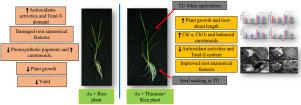Environmental Technology & Innovation ( IF 6.7 ) Pub Date : 2021-01-09 , DOI: 10.1016/j.eti.2021.101368 Poonam Yadav , Sudhakar Srivastava

|
The present study was performed with two contrasting genotypes of rice, tolerant (Pooja) and moderately sensitive (CO-50), to evaluate their differential responses to arsenic (As, 50 mg kg−1 soil) stress without or with thiourea (TU, 6.57 mM) application. The study analyzed tissue specific responses (root, old leaf; OL and young leaf; YL) of rice plants. TU was applied at different stages, viz., seed soaking and 25 days after sowing (DAS) and final harvesting was done at 45 DAS. Arsenic accumulation in Pooja roots (1067.94 g g−1 dw), OL (131.67 g g−1 dw) and YL (38.34 g g−1 dw) was lower than that detected in CO-50 roots (4763.97 g g−1 dw), OL (866.94 g g−1 dw) and YL (334.08 g g−1 dw) in As alone treatment. Arsenic stressed plants of both varieties showed reduced growth, decline in photosynthetic pigments and protein content. There was an increase in activity of antioxidant enzymes, SOD and GPX and total S in both varieties and root anatomical features were disturbed. Pooja showed lesser toxicity as compared to that of CO-50 in terms of various analyzed responses. The positive effects of TU on two varieties were visible as enhanced plant’s growth in comparison to As alone treatment. The biochemical parameters showed a change in As+TU treatment so as to approach towards control value. The positive effect of TU was attributable to significant decline in As concentrations in both varieties. In conclusion, TU application can be a sustainable and feasible way to reduce As toxicity and accumulation in rice in field.
中文翻译:

硫脲对砷污染土壤中两个对比水稻品种(水稻)根,老叶和幼叶的影响
本研究采用两种不同的水稻基因型,即耐性(Pooja)和中度敏感性(CO-50)的水稻,以评估其对砷(砷,50 mg kg -1土壤)在无硫脲或有硫脲(TU, 6.57 mM)应用。该研究分析了水稻植物的组织特异性反应(根,老叶; OL和幼叶; YL)。在不同阶段,即浸种和播种后25天(DAS)施用TU,最后收获在45 DAS进行。Pooja根中的砷积累(1067.94gg -1 dw),OL(131.67gg -1 dw)和YL(38.34gg -1 dw)低于在CO-50根中检测到的(4763.97)gg -1 dw),OL(866.94gg -1 dw)和YL(334.08gg -1dw)在单独治疗中。两种品种的砷胁迫植物均显示出生长减慢,光合色素和蛋白质含量下降。两个品种中抗氧化酶,SOD和GPX的活性以及总S均增加,并且根部解剖特征受到干扰。就各种分析结果而言,Pooja与CO-50相比,毒性较低。与单独使用As相比,TU对两个品种的积极影响可见于植物生长的增强。生化参数显示As + TU处理发生变化,从而接近控制值。TU的积极作用归因于两个品种中As浓度的显着下降。综上所述,TU的应用可能是减少大田中As毒性和水稻累积的一种可持续可行的方法。











































 京公网安备 11010802027423号
京公网安备 11010802027423号